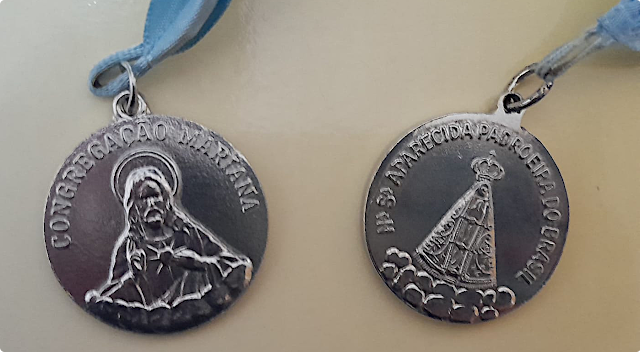The Little Badge
Excerpts of the post presented by Alexandre Martins (Brazilian sodalist) at the blog "Apologeta Mariano".
"In the fervor of the early twentieth century, the sodalities of Our Lady propagated due to various reasons. And, as an army of Mary, felt the natural need for increased organization. How to show the world the sodalities of Our Lady through just a symbol? It was the time of the Nazi swastika, the hammer and sickle of co
mmunism, the sigma of the Integralists … sodalities of Our Lady could not shut up.
The Brazilian badge [1] emerged in Rio de Janeiro (RJ) in the 1920s by drawing a carioca Marian Sodalist. How are Sodalists Marian Mary Queen of soldiers, knights are also hers. It is only natural that the format was a medieval shield. Was topped by three points, symbolizing the three cardinal virtues. Format gave his nickname by locals: the “escudinho” (the Little Badge). (...)
Like any institution, there is a need for a symbol, a mark. And, to the surprise of all Sodalists World was chosen a brand that was created decades ago in Germany. The “Chi-ro” monogram happened during a meeting of the Marian Congregations in Germany [2] 1920s – pre-Nazism – which was first used in flags of sodalities participants. (...)
This monogram means the first two letters – X and P – the name of Christ in Greek (χριστος = “Kristos” = anointed). The letter “M” is for Maria. So symbolically means “to Christ through Mary.” The Blue is the color of Mary. The golden color of Christ the Priest. The hexagon is the representation of creation, as the number six has this meaning – the world was created in six days – simbolizando4 we should create something from the Sodality, as our apostolate. (...)
However, some sodalities of Our Lady – more by ignorance than anything else – do not bother with it and continued to use the flag with the old badge. But at the time also emerged of an association that would use the ancient symbol of the sodalities of Our Lady to mask their real purposes: the Society for the Defense of Tradition, Family and Property – TFP. Created by Plinio Corrêa de Oliveira – a former Sodalist Federation of São Paulo (SP) – TFP for decades would prove as a kind of “sponsor” of social and religious values and 1950s. And the use of the old badge as its symbol in Brazil was because the first members were all Sodalists paulistanos Marian, as well as its founder. The official symbol of the entity was a “lion rampant” armorial, but in Brazil its members wore on their lapels the old badge of sodalities of Our Lady. The intent was simple and clear: as sodalities of Our Lady always been seen as defenders of the Faith and propagator of Christian good deeds, using the Marian distinctive members of the TFP wanted to give legitimacy to their association. But it was also an attitude of rejection of the “modern” Vatican II, hated by members of the TFP as well as repudiation of the popes since John XXIII.
From the 1960s, however, who used the old badge was identified as a member of the TFP, because all Sodalists Marian embraced Rome. (...)
The Brazilian National Confederation in 2002 also created a variation of the distinctive monogram composed solely for the Sodalists of Brazil use. What actually is a “setback” to that used in the Congress of German sodalities of Our Lady, 1920. Unsurprisingly, since it is already used by other sodalities such as the World of Medellin (Colombia) and even the Christian Life Communities, linked to the Jesuits, though more stylized.
In the early twenty-first century, new generations of Sodalists Marian as relexo of his time, began a “wave of nostalgia” and sought the experiences of sodalities of Our Lady of the past. The young Catholic in the 2000s was disappointed with a Catholic pastoral activity which for many was closer to Protestantism. And even with the promulgation of Summorum Pontificum of Pope Benedict XVI, felt that they were “legitimate” to seek the Old. In sodalities of Our Lady of the logo that “back in time” was the use of the old badge "escudinho" by young people. (...)
The badge is an excellent means of propaganda Sodality. Currently all serious organizations use some form of symbol. And the sodalities, very serious as they are, could not fail to have its. Large japanese business corporations insist their employees to use the pins of the company even in the everyday environment: for them, an advertisement, for the employee, an honor to join a great company.



